Antibody data
- Antibody Data
- Antigen structure
- References [30]
- Comments [0]
- Validations
- Western blot [4]
- Flow cytometry [1]
- Other assay [1]
Submit
Validation data
Reference
Comment
Report error
- Product number
- MA5-12984 - Provider product page

- Provider
- Invitrogen Antibodies
- Product name
- CDK4 Monoclonal Antibody (DCS-35)
- Antibody type
- Monoclonal
- Antigen
- Purifed from natural sources
- Description
- MA5-12984 targets Cdk4 in IF, IP, and WB applications and shows reactivity with Human, mouse, Porcine, and Rat samples. The MA5-12984 immunogen is purified recombinant cdk4 protein.
- Reactivity
- Human, Mouse, Rat, Porcine
- Host
- Mouse
- Isotype
- IgG
- Antibody clone number
- DCS-35
- Vial size
- 500 µL
- Concentration
- 0.2 mg/mL
- Storage
- 4° C
Submitted references Anti-tumor activity of the TRPM8 inhibitor BCTC in prostate cancer DU145 cells.
Knockdown of TRPM8 suppresses cancer malignancy and enhances epirubicin-induced apoptosis in human osteosarcoma cells.
Recruitment of trimeric proliferating cell nuclear antigen by G1-phase cyclin-dependent kinases following DNA damage with platinum-based antitumour agents.
The APC/C activator Cdh1 regulates the G2/M transition during differentiation of placental trophoblast stem cells.
Death effector domain-containing protein (DEDD) is required for uterine decidualization during early pregnancy in mice.
Phosphorylation of p27Kip1 regulates assembly and activation of cyclin D1-Cdk4.
Cyclic AMP inhibits the proliferation of thyroid carcinoma cell lines through regulation of CDK4 phosphorylation.
Regulation of keratinocyte proliferation in rats with deep, partial-thickness scald: modulation of cyclin D1-cyclin-dependent kinase 4 and histone H1 kinase activity of M-phase promoting factor.
Contribution of extracellular signal-regulated kinases to the IL-1-induced growth inhibition of human melanoma cells A375.
Differential modification of p27Kip1 controls its cyclin D-cdk4 inhibitory activity.
Inhibition of prostate cancer growth by muscadine grape skin extract and resveratrol through distinct mechanisms.
Akt shows variable sensitivity to an Hsp90 inhibitor depending on cell context.
Critical requirement for cell cycle inhibitors in sustaining nonproliferative states.
The LxCxE pRb interaction domain of cyclin D1 is dispensable for murine development.
The role of p28GANK in rat oval cells activation and proliferation.
Requirement for CDK4 kinase function in breast cancer.
Cyclin D1-dependent kinase activity in murine development and mammary tumorigenesis.
p21Cip1 and p27Kip1 induce distinct cell cycle effects and differentiation programs in myeloid leukemia cells.
In vitro and in vivo pharmacokinetic-pharmacodynamic relationships for the trisubstituted aminopurine cyclin-dependent kinase inhibitors olomoucine, bohemine and CYC202.
p107 inhibits G1 to S phase progression by down-regulating expression of the F-box protein Skp2.
p53, p16 and cyclin D1: molecular determinants of radiotherapy treatment response in oral carcinoma.
The Cyclin-dependent kinase inhibitor CYC202 (R-roscovitine) inhibits retinoblastoma protein phosphorylation, causes loss of Cyclin D1, and activates the mitogen-activated protein kinase pathway.
Expression of angiotensin type II receptor downregulates Cdk4 synthesis and inhibits cell-cycle progression.
Regulation and role of p21 and p27 cyclin-dependent kinase inhibitors during hepatocyte differentiation and growth.
Interaction of Hsp90 with the nascent form of the mutant epidermal growth factor receptor EGFRvIII.
Autoimmune responses to proliferating cell nuclear antigen multiprotein complexes involved in cell proliferation are strongly associated with their structure and biologic function in patients with systemic lupus erythematosus.
Regulation of cell cycle and cyclins by 16alpha-hydroxyestrone in MCF-7 breast cancer cells.
Reconstitution of cyclin D1-associated kinase activity drives terminally differentiated cells into the cell cycle.
Targeted disruption of CDK4 delays cell cycle entry with enhanced p27(Kip1) activity.
Targeted disruption of CDK4 delays cell cycle entry with enhanced p27(Kip1) activity.
Liu T, Fang Z, Wang G, Shi M, Wang X, Jiang K, Yang Z, Cao R, Tao H, Wang X, Zhou J
Oncology letters 2016 Jan;11(1):182-188
Oncology letters 2016 Jan;11(1):182-188
Knockdown of TRPM8 suppresses cancer malignancy and enhances epirubicin-induced apoptosis in human osteosarcoma cells.
Wang Y, Yang Z, Meng Z, Cao H, Zhu G, Liu T, Wang X
International journal of biological sciences 2013;10(1):90-102
International journal of biological sciences 2013;10(1):90-102
Recruitment of trimeric proliferating cell nuclear antigen by G1-phase cyclin-dependent kinases following DNA damage with platinum-based antitumour agents.
He G, Kuang J, Koomen J, Kobayashi R, Khokhar AR, Siddik ZH
British journal of cancer 2013 Oct 29;109(9):2378-88
British journal of cancer 2013 Oct 29;109(9):2378-88
The APC/C activator Cdh1 regulates the G2/M transition during differentiation of placental trophoblast stem cells.
Naoe H, Chiyoda T, Ishizawa J, Masuda K, Saya H, Kuninaka S
Biochemical and biophysical research communications 2013 Jan 11;430(2):757-62
Biochemical and biophysical research communications 2013 Jan 11;430(2):757-62
Death effector domain-containing protein (DEDD) is required for uterine decidualization during early pregnancy in mice.
Mori M, Kitazume M, Ose R, Kurokawa J, Koga K, Osuga Y, Arai S, Miyazaki T
The Journal of clinical investigation 2011 Jan;121(1):318-27
The Journal of clinical investigation 2011 Jan;121(1):318-27
Phosphorylation of p27Kip1 regulates assembly and activation of cyclin D1-Cdk4.
Larrea MD, Liang J, Da Silva T, Hong F, Shao SH, Han K, Dumont D, Slingerland JM
Molecular and cellular biology 2008 Oct;28(20):6462-72
Molecular and cellular biology 2008 Oct;28(20):6462-72
Cyclic AMP inhibits the proliferation of thyroid carcinoma cell lines through regulation of CDK4 phosphorylation.
Rocha AS, Paternot S, Coulonval K, Dumont JE, Soares P, Roger PP
Molecular biology of the cell 2008 Nov;19(11):4814-25
Molecular biology of the cell 2008 Nov;19(11):4814-25
Regulation of keratinocyte proliferation in rats with deep, partial-thickness scald: modulation of cyclin D1-cyclin-dependent kinase 4 and histone H1 kinase activity of M-phase promoting factor.
Xie T, Niu Y, Ge K, Lu S
The Journal of surgical research 2008 Jun 1;147(1):9-14
The Journal of surgical research 2008 Jun 1;147(1):9-14
Contribution of extracellular signal-regulated kinases to the IL-1-induced growth inhibition of human melanoma cells A375.
Arakawa T, Yamamura T, Hattori T, Hayashi H, Mori A, Yoshida A, Uchida C, Kitagawa M, Onozaki K
International immunopharmacology 2008 Jan;8(1):80-9
International immunopharmacology 2008 Jan;8(1):80-9
Differential modification of p27Kip1 controls its cyclin D-cdk4 inhibitory activity.
James MK, Ray A, Leznova D, Blain SW
Molecular and cellular biology 2008 Jan;28(1):498-510
Molecular and cellular biology 2008 Jan;28(1):498-510
Inhibition of prostate cancer growth by muscadine grape skin extract and resveratrol through distinct mechanisms.
Hudson TS, Hartle DK, Hursting SD, Nunez NP, Wang TT, Young HA, Arany P, Green JE
Cancer research 2007 Sep 1;67(17):8396-405
Cancer research 2007 Sep 1;67(17):8396-405
Akt shows variable sensitivity to an Hsp90 inhibitor depending on cell context.
Theodoraki MA, Kunjappu M, Sternberg DW, Caplan AJ
Experimental cell research 2007 Nov 1;313(18):3851-8
Experimental cell research 2007 Nov 1;313(18):3851-8
Critical requirement for cell cycle inhibitors in sustaining nonproliferative states.
Pajalunga D, Mazzola A, Salzano AM, Biferi MG, De Luca G, Crescenzi M
The Journal of cell biology 2007 Mar 12;176(6):807-18
The Journal of cell biology 2007 Mar 12;176(6):807-18
The LxCxE pRb interaction domain of cyclin D1 is dispensable for murine development.
Landis MW, Brown NE, Baker GL, Shifrin A, Das M, Geng Y, Sicinski P, Hinds PW
Cancer research 2007 Aug 15;67(16):7613-20
Cancer research 2007 Aug 15;67(16):7613-20
The role of p28GANK in rat oval cells activation and proliferation.
Shan YF, Zhou WP, Fu XY, Yan HX, Yang W, Liu SQ, Cao HF, Kang B, Wu MC, Wang HY
Liver international : official journal of the International Association for the Study of the Liver 2006 Mar;26(2):240-7
Liver international : official journal of the International Association for the Study of the Liver 2006 Mar;26(2):240-7
Requirement for CDK4 kinase function in breast cancer.
Yu Q, Sicinska E, Geng Y, Ahnström M, Zagozdzon A, Kong Y, Gardner H, Kiyokawa H, Harris LN, Stål O, Sicinski P
Cancer cell 2006 Jan;9(1):23-32
Cancer cell 2006 Jan;9(1):23-32
Cyclin D1-dependent kinase activity in murine development and mammary tumorigenesis.
Landis MW, Pawlyk BS, Li T, Sicinski P, Hinds PW
Cancer cell 2006 Jan;9(1):13-22
Cancer cell 2006 Jan;9(1):13-22
p21Cip1 and p27Kip1 induce distinct cell cycle effects and differentiation programs in myeloid leukemia cells.
Muñoz-Alonso MJ, Acosta JC, Richard C, Delgado MD, Sedivy J, León J
The Journal of biological chemistry 2005 May 6;280(18):18120-9
The Journal of biological chemistry 2005 May 6;280(18):18120-9
In vitro and in vivo pharmacokinetic-pharmacodynamic relationships for the trisubstituted aminopurine cyclin-dependent kinase inhibitors olomoucine, bohemine and CYC202.
Raynaud FI, Whittaker SR, Fischer PM, McClue S, Walton MI, Barrie SE, Garrett MD, Rogers P, Clarke SJ, Kelland LR, Valenti M, Brunton L, Eccles S, Lane DP, Workman P
Clinical cancer research : an official journal of the American Association for Cancer Research 2005 Jul 1;11(13):4875-87
Clinical cancer research : an official journal of the American Association for Cancer Research 2005 Jul 1;11(13):4875-87
p107 inhibits G1 to S phase progression by down-regulating expression of the F-box protein Skp2.
Rodier G, Makris C, Coulombe P, Scime A, Nakayama K, Nakayama KI, Meloche S
The Journal of cell biology 2005 Jan 3;168(1):55-66
The Journal of cell biology 2005 Jan 3;168(1):55-66
p53, p16 and cyclin D1: molecular determinants of radiotherapy treatment response in oral carcinoma.
Jayasurya R, Francis G, Kannan S, Lekshminarayanan K, Nalinakumari KR, Abraham T, Abraham EK, Nair MK
International journal of cancer 2004 May 1;109(5):710-6
International journal of cancer 2004 May 1;109(5):710-6
The Cyclin-dependent kinase inhibitor CYC202 (R-roscovitine) inhibits retinoblastoma protein phosphorylation, causes loss of Cyclin D1, and activates the mitogen-activated protein kinase pathway.
Whittaker SR, Walton MI, Garrett MD, Workman P
Cancer research 2004 Jan 1;64(1):262-72
Cancer research 2004 Jan 1;64(1):262-72
Expression of angiotensin type II receptor downregulates Cdk4 synthesis and inhibits cell-cycle progression.
Gingras B, Rodier G, Giasson E, Coulombe P, Chassagne C, Meloche S
Oncogene 2003 May 1;22(17):2633-42
Oncogene 2003 May 1;22(17):2633-42
Regulation and role of p21 and p27 cyclin-dependent kinase inhibitors during hepatocyte differentiation and growth.
Ilyin GP, Glaise D, Gilot D, Baffet G, Guguen-Guillouzo C
American journal of physiology. Gastrointestinal and liver physiology 2003 Jul;285(1):G115-27
American journal of physiology. Gastrointestinal and liver physiology 2003 Jul;285(1):G115-27
Interaction of Hsp90 with the nascent form of the mutant epidermal growth factor receptor EGFRvIII.
Lavictoire SJ, Parolin DA, Klimowicz AC, Kelly JF, Lorimer IA
The Journal of biological chemistry 2003 Feb 14;278(7):5292-9
The Journal of biological chemistry 2003 Feb 14;278(7):5292-9
Autoimmune responses to proliferating cell nuclear antigen multiprotein complexes involved in cell proliferation are strongly associated with their structure and biologic function in patients with systemic lupus erythematosus.
Kogure T, Takasaki Y, Takeuchi K, Yamada H, Nawata M, Ikeda K, Matsushita M, Matsudaira R, Kaneda K, Terasawa K, Hashimoto H
Arthritis and rheumatism 2002 Nov;46(11):2946-56
Arthritis and rheumatism 2002 Nov;46(11):2946-56
Regulation of cell cycle and cyclins by 16alpha-hydroxyestrone in MCF-7 breast cancer cells.
Lewis JS, Thomas TJ, Klinge CM, Gallo MA, Thomas T
Journal of molecular endocrinology 2001 Dec;27(3):293-307
Journal of molecular endocrinology 2001 Dec;27(3):293-307
Reconstitution of cyclin D1-associated kinase activity drives terminally differentiated cells into the cell cycle.
Latella L, Sacco A, Pajalunga D, Tiainen M, Macera D, D'Angelo M, Felici A, Sacchi A, Crescenzi M
Molecular and cellular biology 2001 Aug;21(16):5631-43
Molecular and cellular biology 2001 Aug;21(16):5631-43
Targeted disruption of CDK4 delays cell cycle entry with enhanced p27(Kip1) activity.
Tsutsui T, Hesabi B, Moons DS, Pandolfi PP, Hansel KS, Koff A, Kiyokawa H
Molecular and cellular biology 1999 Oct;19(10):7011-9
Molecular and cellular biology 1999 Oct;19(10):7011-9
Targeted disruption of CDK4 delays cell cycle entry with enhanced p27(Kip1) activity.
Tsutsui T, Hesabi B, Moons DS, Pandolfi PP, Hansel KS, Koff A, Kiyokawa H
Molecular and cellular biology 1999 Oct;19(10):7011-9
Molecular and cellular biology 1999 Oct;19(10):7011-9
No comments: Submit comment
Supportive validation
- Submitted by
- Invitrogen Antibodies (provider)
- Main image

- Experimental details
- Western blot of Cdk4 using Cdk4 Monoclonal Antibody (Product # MA5-12984) on MAD109 Cells.
- Submitted by
- Invitrogen Antibodies (provider)
- Main image
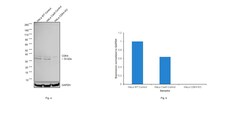
- Experimental details
- Knockout of CDK4 was achieved by CRISPR-Cas9 genome editing using LentiArray™ Lentiviral sgRNA (Product # A32042, Assay ID CRISPR1007917_LV) and LentiArray Cas9 Lentivirus (Product # A32064). Western blot analysis of CDK4 was performed by loading 50 µg of HeLa Wild Type (Lane 1), HeLa Cas9 (Lane 2) andHeLa CDK4 KO (Lane 3) whole cell extracts. The samples were electrophoresed using NuPAGE™ Novex™ 4-12% Bis-Tris Protein Gel (Product # NP0322BOX). Resolved proteins were then transferred onto a nitrocellulose membrane (Product # IB23001) by iBlot® 2 Dry Blotting System (Product # IB21001). The blot was probed with Anti-CDK4 Monoclonal Antibody (DCS-35) (Product # MA5-12984, 1:1,000 dilution) and Goat anti-Mouse IgG (H+L) Superclonal™ Recombinant Secondary Antibody, HRP (Product # A28177, 1:8,000 dilution) using the iBright FL 1000 (Product # A32752). Chemiluminescent detection was performed using SuperSignal™ West Dura Extended Duration Substrate (Product # 34076). Loss of signal upon CRISPR mediated knockout (KO) using the LentiArray™ CRISPR product line confirms that antibody is specific to CDK4. An uncharacterized band was observed in all the samples at 35 kDa.
- Submitted by
- Invitrogen Antibodies (provider)
- Main image
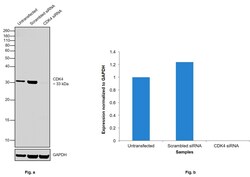
- Experimental details
- Western blot was performed using Anti-CDK4 Monoclonal Antibody (DCS-35) (Product # MA5-12984) and a 33 kDa band corresponding to CDK4 was observed across the cell lines tested and tissues tested. Circulating tissue IgG band (*) at ~ 25 kDa was observed in Mouse Lung tissue. Whole cell extracts (30 µg lysate) of HEK-293 (Lane 1), K-562 (Lane 2), A549 (Lane 3), HeLa (Lane 4), NIH/3T3 (Lane 5), PC12 (Lane 6), Mouse Lung (Lane 7), Rat Lung (Lane 8) were electrophoresed using NuPAGE™ 4-12% Bis-Tris Protein Gel (Product # NP0322BOX). Resolved proteins were then transferred onto a Nitrocellulose membrane (Product # IB23002) by iBlot® 2 Dry Blotting System (Product # IB21001). The blot was probed with the primary antibody (1:1,000) and detected by chemiluminescence with Goat anti-Mouse IgG (H+L) Superclonal™ Recombinant Secondary Antibody, HRP (Product # A28177, 1:2,000) using the iBright FL 1000 (Product # A32752). Chemiluminescent detection was performed using Novex® ECL Chemiluminescent Substrate Reagent Kit (Product # WP20005).
- Submitted by
- Invitrogen Antibodies (provider)
- Main image
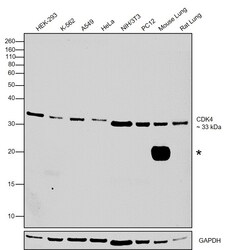
- Experimental details
- Western blot was performed using Anti-CDK4 Monoclonal Antibody (DCS-35) (Product # MA5-12984) and a 33kDa band corresponding to CDK4 was observed across the cell lines tested and tissues tested. Whole cell extracts (30 µg lysate) of HEK-293 (Lane 1), K-562 (Lane 2), A549 (Lane 3), HeLa (Lane 4), NIH/3T3 (Lane 5), PC12 (Lane 6), Mouse Lung (Lane 7), Rat Lung (Lane 8) were electrophoresed using NuPAGE™ 4-12% Bis-Tris Protein Gel (Product # NP0322BOX). Resolved proteins were then transferred onto a Nitrocellulose membrane (Product # IB23002) by iBlot® 2 Dry Blotting System (Product # IB21001). The blot was probed with the primary antibody (1:1000) and detected by chemiluminescence with Goat anti-Mouse IgG (H+L) Superclonal™ Recombinant Secondary Antibody, HRP (Product # A28177, 1:2000) using the iBright FL 1000 (Product # A32752). Chemiluminescent detection was performed using Novex® ECL Chemiluminescent Substrate Reagent Kit (Product # WP20005).
Supportive validation
- Submitted by
- Invitrogen Antibodies (provider)
- Main image
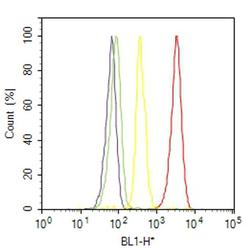
- Experimental details
- Flow cytometry analysis of Cdk4 was done on K-562 cells. Cells were fixed with 70% ethanol for 10 minutes, permeabilized with 0.25% Triton™ X-100 for 20 minutes, and blocked with 5% BSA for 30 minutes at room temperature. Cells were labeled with Cdk4 Mouse Monoclonal Antibody (MA512984, red histogram) or with mouse isotype control (yellow histogram) at 3-5 ug/million cells in 2.5% BSA. After incubation at room temperature for 2 hours, the cells were labeled with Alexa Fluor® 488 Rabbit Anti-Mouse Secondary Antibody (A11059) at a dilution of 1:400 for 30 minutes at room temperature. The representative 10,000 cells were acquired and analyzed for each sample using an Attune® Acoustic Focusing Cytometer. The purple histogram represents unstained control cells and the green histogram represents no-primary-antibody control.
Supportive validation
- Submitted by
- Invitrogen Antibodies (provider)
- Main image
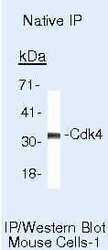
- Experimental details
- Immunoprecipitation of Cdk4 using Cdk4 Monoclonal Antibody (Product # MA5-12984) on Native Mouse MAD109 Cells.
 Explore
Explore Validate
Validate Learn
Learn Western blot
Western blot Immunoprecipitation
Immunoprecipitation